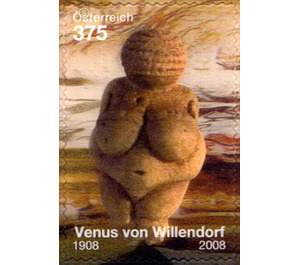3D Stamps - Austria / II. Republic of Austria 2008 - 375 Euro Cent
Theme: Art & Culture
| Country | Austria / II. Republic of Austria |
| Issue Date | 2008 |
| Face Value | 375.00 |
| Edition Issued | 350,000 |
| Stamp Type | Commemorative |
| Item Type | Stamp |
| Chronological Issue Number | 2094 |
| Chronological Chapter | OOS-OE2 |
| SID | 654446 |
| In 31 Wishlists | |
The Venus of Willendorf is Austria's best known and most valuable find from the younger Paleolithic (Upper Palaeolithic). A very special brand was created for this outstanding object: a three-dimensional effect lets us admire the Venus in seemingly plastic form. No doubt: this innovative lenticular image brand is yet another milestone in contemporary stamp design! The sculpture of Venus was created 25,000 years ago. On August 7, 1908, she was found in Willendorf in the Wachau. The 11 cm high figure of fine limestone is preserved almost intact. Shown is an obese, unclothed woman. Strong hips, protruding belly and heavy breasts determine the striking look. The arms are only hinted at, the wrists are adorned with jagged bracelets. Upper and lower legs are formed close to nature, the feet are missing. On weak shoulders sits a slightly inclined large head without a face, almost entirely decorated with a complicated hairstyle of curls that reach deep into the neck. Paint remains show that the sculpture was originally painted with red chalk. (By the way: The original is in the Natural History Museum in Vienna.) The place Willendorf in the Wachau is located on the left bank of the Danube. During the younger Paleolithic, the slopes of the Danube valley were part of the hunting grounds of the ice-age hunters. In the summer of 1908, the Natural History Museum conducted systematic excavations under the direction of Josef Szombathy. Particular attention was paid to the site Willendorf II, which lay in the area of the route of the Donauuferbahn. Willendorf II is certainly the most important of the seven well-known sites and one of the most important in Central Europe for the study of paleolithography. The limestone figure was found in the 9th layer of culture, lying next to a large hearth with charcoal remains. 19 years later you found - only a few meters from the first locality - the 19 cm large Venus II, carved from the tusk of a mammoth. Of all the 130 Venus statuettes found in Europe and Asia, the Venus of Willendorf is the most beautiful, oldest - and above all a completely preserved - figure. The find represents a world sensation in professional circles. One thing is certain: the specimen has a strikingly similarities with Eastern European statuettes. Common to all is the emphasis on sexual characteristics. It is noteworthy that all these archaeological finds are subject to the same geometric principle: they can be enrolled in a rhombus with astonishing accuracy. Venus statuettes are considered fertility idols. The abundance of the body may also have been an expression of the desire for sufficient food and hunting luck. Striking is: The statuettes found so far come from permanent settlements.


